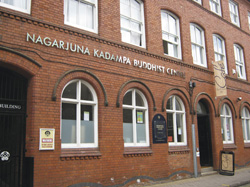On Thursday 3rd of March 2016, Dr Ruth Young from the University of Leicester came to talk to us about the translation of Buddhist faith practices from their origins in South Asia to the UK. In one hour we were given a whistle stop tour of Buddhism from Lumbini to Leicester. This project is being carried out in conjunction with Dr Young’s college Deirdre O’Sullivan. It focused on an exploration of Buddhist structures, monuments and objects as they are found and experienced in South Asia, compared to how these features are translated into a UK context. Dr Young talked about the tensions of buildings in faith and heritage contexts. Buddhism is often associated with monumentality and ritual, previous archaeological investigations usually focus on identifying stupas and relics, creating typologies and sequences of structures but often forget to think about the influence of lived faith practices.
It was interesting to see the varied locations of translated Buddhist Viharas in the UK, from a Quaker meeting hall to a semi-detached residential property, what objects occur in UK Buddhist contexts (a nineteenth century repaired Buddha, or a 3D printed version from Cumbria) and the beliefs of followers of Buddhism within the UK. Key themes occurring in this research are the significance of meditation practices, the intermingling of defined Buddhist sects and how action primarily defines space for lived faith practices. Dr Young’s research is ongoing.
Written by Jemma Singleton

